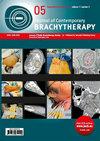Dosimetric comparison of intra-cavitary brachytherapy technique with free-hand (intra-cavitary + interstitial) technique in cervical cancer
IF 1.1
4区 医学
Q4 ONCOLOGY
引用次数: 0
Abstract
Purpose:The aim of the study was to dosimetrically compare intra-cavitary brachytherapy technique (ICBT) with free-hand (intra-cavitary + interstitial, IC + IS) technique.
Material and methods:
Twenty seven locally advanced carcinoma cervix patients were included in the study. Patients with more than medial 1/3rd parametrial residual disease without extending upto lateral pelvic wall were included, following external beam radiotherapy (EBRT), in which cobalt-60 high-dose-rate (60Co HDR) brachytherapy source was used. Dose for both plans were 6.5 Gy × 4 fractions, 2 fractions per day, 6 hours apart, over 2 days. Free-hand brachytherapy technique, consisted of placement of central tandem and 2 ovoids along with needles without using template, was applied. Two plans were generated by activating and deactivating the needles, and compared by normalizing to V100.
Results:
A total of 79 needles were applied. Using paired-t test, dosimetric comparison of both the plans was done. Free-hand plan had a significant higher mean V90 (volume receiving 90% of the dose) of 94.2% compared with 87.22% in ICBT plan (p ≤ 0.0001). Free-hand and ICBT plans presented a mean V100 values of 89.06% and 81.51% (p ≤ 0.0001), respectively, favoring free-hand plan. The mean D90 (dose to 90% volume), D98, and D100 of free-hand plan were 6.28 Gray (Gy), 4.91 Gy, and 3.62 Gy, respectively, but equivalent parameters in ICBT plan were 5.26 Gy, 3.72 Gy, and 2.61 Gy, with p value ≤ 0.0001. In both the plans, D2cc of the bladder, rectum, and sigmoid were 4.59 Gy, 3.98 Gy, 2.77 Gy, and 4.46 Gy, 3.90 Gy, 2.67 Gy, respectively, with no statistical significance.
Conclusions:
Free-hand brachytherapy (IC + IS) achieves a statistically significant better dose distribution to high-risk clinical target volume (HR-CTV) comparing with ICBT technique with similar dose to organs at risk.
宫颈癌腔内近距离治疗技术与自由手(腔内+间质)技术的放射量比较
目的:该研究旨在从剂量学角度比较腔内近距离放射治疗技术(ICBT)和自由手(腔内+间质,IC+IS)技术。研究对象包括宫旁残留病灶超过内侧 1/3 且未延伸至盆腔侧壁的患者,这些患者在接受外照射放射治疗(EBRT)后,使用了钴-60 高剂量率近距离放射源(60Co HDR)。两种方案的剂量均为 6.5 Gy × 4 次,每天 2 次,每次间隔 6 小时,持续 2 天。采用了自由手近距离治疗技术,包括在不使用模板的情况下放置中央串联体和两个椭圆形针头。通过激活和停用针头生成两个计划,并与 V100 进行归一化比较。结果:共使用了 79 支针,使用配对 t 检验对两种计划进行了剂量比较。自由手计划的平均 V90(接受 90% 剂量的体积)明显高于 ICBT 计划的 87.22%(P ≤ 0.0001)。徒手计划和 ICBT 计划的平均 V100 值分别为 89.06% 和 81.51%(p ≤ 0.0001),徒手计划更胜一筹。自由手计划的平均 D90(90% 容积的剂量)、D98 和 D100 分别为 6.28 Gray (Gy)、4.91 Gy 和 3.62 Gy,但 ICBT 计划的同等参数分别为 5.26 Gy、3.72 Gy 和 2.61 Gy,p 值≤ 0.0001。两种方案中,膀胱、直肠和乙状结肠的 D2cc 分别为 4.59 Gy、3.98 Gy、2.77 Gy 和 4.46 Gy、3.90 Gy、2.67 Gy,均无统计学意义。
本文章由计算机程序翻译,如有差异,请以英文原文为准。
求助全文
约1分钟内获得全文
求助全文
来源期刊

Journal of Contemporary Brachytherapy
ONCOLOGY-RADIOLOGY, NUCLEAR MEDICINE & MEDICAL IMAGING
CiteScore
2.40
自引率
14.30%
发文量
54
审稿时长
16 weeks
期刊介绍:
The “Journal of Contemporary Brachytherapy” is an international and multidisciplinary journal that will publish papers of original research as well as reviews of articles. Main subjects of the journal include: clinical brachytherapy, combined modality treatment, advances in radiobiology, hyperthermia and tumour biology, as well as physical aspects relevant to brachytherapy, particularly in the field of imaging, dosimetry and radiation therapy planning. Original contributions will include experimental studies of combined modality treatment, tumor sensitization and normal tissue protection, molecular radiation biology, and clinical investigations of cancer treatment in brachytherapy. Another field of interest will be the educational part of the journal.
 求助内容:
求助内容: 应助结果提醒方式:
应助结果提醒方式:


